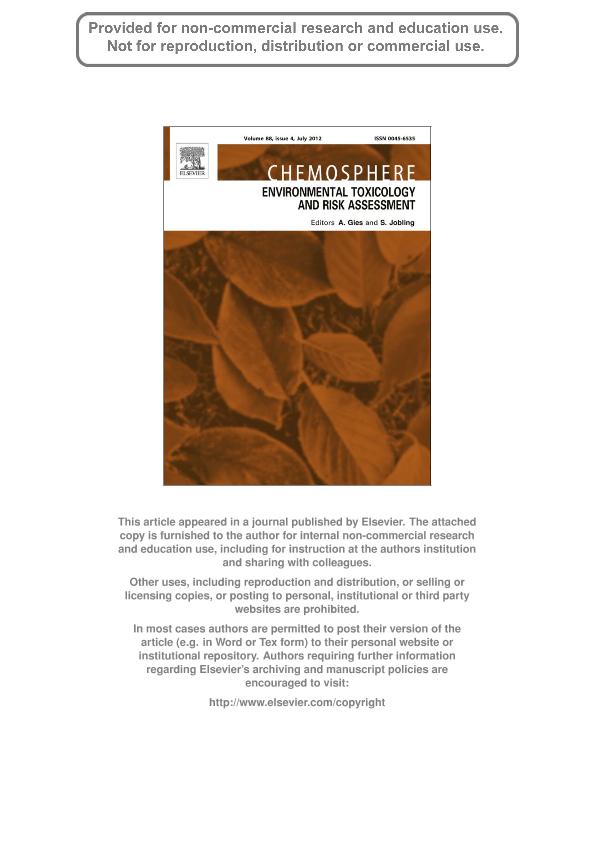Artículo
Binary mixtures of azinphos-methyl oxon and chlorpyrifos oxon produce in vitro synergistic cholinesterase inhibition in Planorbarius corneus
Fecha de publicación:
07/2012
Editorial:
Pergamon-Elsevier Science Ltd
Revista:
Chemosphere
ISSN:
0045-6535
Idioma:
Inglés
Tipo de recurso:
Artículo publicado
Clasificación temática:
Resumen
In this study, the cholinesterase (ChE) and carboxylesterase (CES) activities present in whole organism homogenates from Planorbarius corneus and their in vitro sensitivity to organophosphorous (OP) pesticides were studied. Firstly, a characterization of ChE and CES activities using different substrates and selective inhibitors was performed. Secondly, the effects of azinphos-methyl oxon (AZM-oxon) and chlorpyrifos oxon (CPF-oxon), the active oxygen analogs of the OP insecticides AZM and CPF, on ChE and CES activities were evaluated. Finally, it was analyzed whether binary mixtures of the pesticide oxons cause additive, antagonistic or synergistic ChE inhibition in P. corneus homogenates. The results showed that the extracts of P. corneus preferentially hydrolyzed acetylthiocholine (AcSCh) over propionylthiocholine (PrSCh) and butyrylthiocholine (BuSCh). Besides, AcSCh hydrolyzing activity was inhibited by low concentrations of BW284c51, a selective inhibitor of AChE activity, and also by high concentrations of substrate. These facts suggest the presence of a typical AChE activity in this species. However, the different dose-response curves observed with BW284c51 when using PrSCh or BuSCh instead of AcSCh suggest the presence of at least another ChE activity. This would probably correspond to an atypical BuChE. Regarding CES activity, the highest specific activity was obtained when using 2-naphthyl acetate (2-NA), followed by 1-naphthyl acetate (1-NA); p-nitrophenyl acetate (p-NPA), and p-nitrophenyl butyrate (p-NPB). The comparison of the IC50 values revealed that, regardless of the substrate used, CES activity was approximately one order of magnitude more sensitive to AZM-oxon than ChE activity. Although ChE activity was very sensitive to CPF-oxon, CES activity measured with 1-NA, 2-NA, and p-NPA was poorly inhibited by this pesticide. In contrast, CES activity measured with p-NPB was equally sensitive to CPF-oxon than ChE activity. Several specific binary combinations of AZM-oxon and CPF-oxon caused a synergistic effect on the ChE inhibition in P. corneus homogenates. The degree of synergism tended to increase as the ratio of AZM-oxon to CPF-oxon decreased. These results suggest that synergism is likely to occur in P. corneus snails exposed in vivo to binary mixtures of the OPs AZM and CPF.
Palabras clave:
Carboxylesterase
,
Cholinesterase
,
Invertebrate
,
Mixtures
,
Pesticides
Archivos asociados
Licencia
Identificadores
Colecciones
Articulos(OCA CIUDAD UNIVERSITARIA)
Articulos de OFICINA DE COORDINACION ADMINISTRATIVA CIUDAD UNIVERSITARIA
Articulos de OFICINA DE COORDINACION ADMINISTRATIVA CIUDAD UNIVERSITARIA
Citación
Cacciatore, Luis Claudio; Kristoff, Gisela; Verrengia Guerrero, Noemí Rosario; Cochon, Adriana; Binary mixtures of azinphos-methyl oxon and chlorpyrifos oxon produce in vitro synergistic cholinesterase inhibition in Planorbarius corneus; Pergamon-Elsevier Science Ltd; Chemosphere; 88; 4; 7-2012; 450-458
Compartir
Altmétricas




